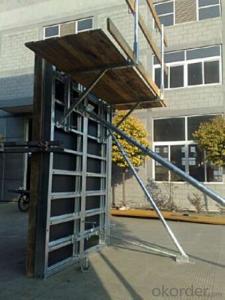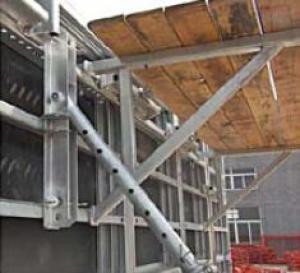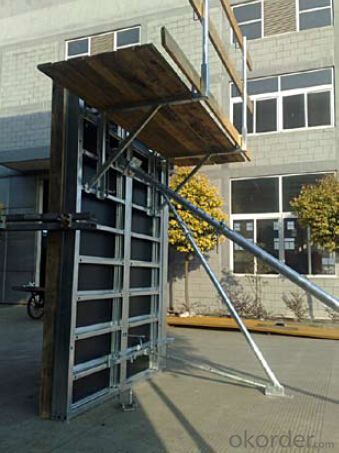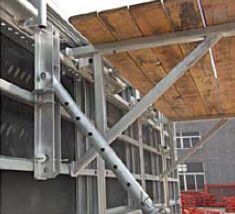Steel-Frame Working Platformfor Formwork and Scaffolding systems
- Loading Port:
- Tianjin
- Payment Terms:
- TT OR LC
- Min Order Qty:
- 50 m²
- Supply Capability:
- 1000 m²/month
OKorder Service Pledge
OKorder Financial Service
You Might Also Like
Steel-frame Formwork SF-140
Characteristics:
◆ Few parts for fast forming.
◆ Max. Concrete pressure: 80KN/m2.
◆ Hot-dip galvanized steel frame.
◆ The thickness of plywood is 18mm & the panel is 14cm.
◆ Compatibility with Hunnebeck Manto system due to similar edge profile.
System Details & Application:
◆ Neat joint and fast assembling with aligning panel clamp.
◆ Flexible panel arrangement and height extension.
◆ The selection of panels.
◆ Kinds of panel connectors.
◆ Corner clamp application.
◆ Length adjustment application.
◆ Height adjustment & aligning strut.
◆ Walkway bracket & platform.
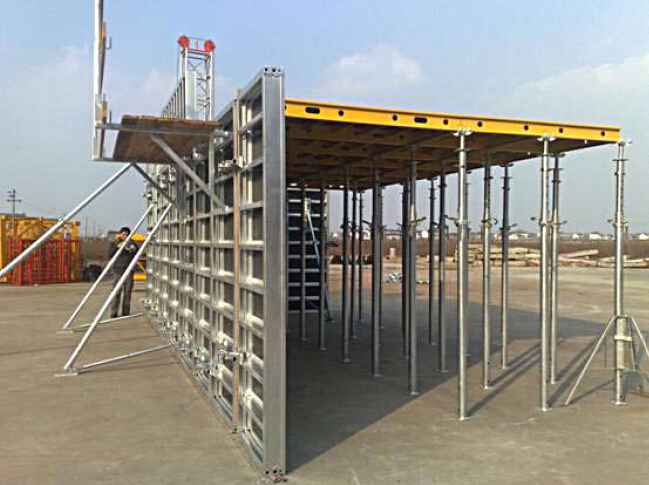
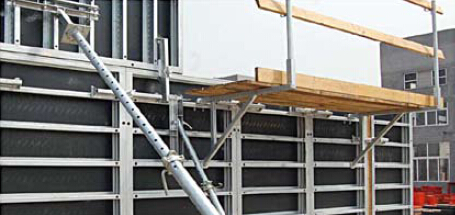
- Q: How does steel formwork handle concrete vibration during pouring?
- Steel formwork, widely used in concrete pouring processes, is a versatile and durable construction material. It possesses several advantages when it comes to managing concrete vibration during pouring. To begin with, the high strength and rigidity of steel formwork enable it to withstand the intense vibrations caused by the pouring of concrete. Its robustness ensures stability and prevents potential deformation or collapse that weaker materials might experience. Moreover, steel formwork is designed with interlocking systems and tight joints, minimizing the possibility of concrete leakage. This containment of the concrete within the formwork streamlines the pouring process, reducing the need for excessive cleanup or rework. Furthermore, steel formwork efficiently transmits vibrations throughout its structure. This transmission aids in eliminating air bubbles and voids, resulting in a more uniform and compact final product. Effective vibration transmission enhances the overall strength and durability of the structure. Lastly, steel formwork is highly reusable and easily disassembled, making it ideal for multiple projects. This cost-effective and sustainable quality reduces the requirement for constant replacement of formwork materials. The ability to reuse steel formwork also ensures its consistent effectiveness in handling concrete vibration over time. In conclusion, steel formwork is a dependable and efficient material for managing concrete vibration during pouring. Its strength, stability, and vibration transmission capabilities make it a preferred choice in construction projects involving concrete pouring and compaction.
- Q: How does steel formwork affect the structural integrity of a building?
- Steel formwork is a construction technique that utilizes steel molds to create the desired shape and structure of concrete elements within a building. Its role in the construction process is pivotal and it impacts the structural integrity of a building in various aspects. To begin with, steel formwork acts as a robust and rigid support system for the wet concrete during pouring and setting. Its strength guarantees that the concrete retains its desired shape and prevents any deformation or collapse. This is particularly crucial for structural elements such as beams, columns, and walls, as it ensures their correct alignment and stability. Moreover, steel formwork allows for precise and accurate construction. The molds can be fabricated with exceptional precision, resulting in concrete elements with accurate dimensions and shapes. This precision is vital for maintaining the structural integrity of the building, as even the slightest deviation or misalignment can compromise its overall strength and stability. Furthermore, steel formwork produces a smooth surface finish for the concrete. This smoothness is not only aesthetically pleasing but also contributes to the structural integrity of the building. A smooth surface reduces the chances of cracks, voids, or air pockets in the concrete, which can weaken its strength and durability. In addition, steel formwork offers durability and reusability. Unlike other types of formwork such as wood or plastic, steel formwork can withstand multiple uses without compromising its structural integrity. This reusability not only saves construction costs but also ensures consistency in the quality of the concrete elements throughout the building. Lastly, steel formwork enhances the overall structural stability of the building. The use of steel molds creates a rigid framework that evenly and efficiently distributes the loads. This distribution minimizes the risk of localized stress concentrations, thereby improving the structural integrity of the building and increasing its resistance to external forces such as wind, earthquakes, or heavy loads. In conclusion, steel formwork has a significant positive impact on the structural integrity of a building. It provides a strong support system, ensures precision and accuracy, offers a smooth surface finish, provides durability and reusability, and enhances overall structural stability. All of these factors contribute to the strength, stability, and longevity of the building, making steel formwork an essential component in modern construction practices.
- Q: What are the safety considerations when using steel formwork?
- When using steel formwork, there are several safety considerations that need to be taken into account. Firstly, it is important to ensure that the formwork is properly installed and secured to prevent any collapses or accidents. Regular inspections should be conducted to check for any signs of wear or damage that could compromise its stability. Another safety consideration is the proper handling and storage of steel formwork. It can be heavy and cumbersome, so workers should be trained in proper lifting techniques to avoid strains or injuries. Adequate storage facilities should be provided to prevent any damage or tripping hazards. Additionally, when working with steel formwork, workers should wear appropriate personal protective equipment (PPE) such as helmets, gloves, and safety boots to protect themselves from any potential hazards or falling debris. They should also be trained in safe work practices, including proper use of tools and equipment, as well as the correct procedures for dismantling the formwork after use. Overall, by following these safety considerations, the risks associated with using steel formwork can be minimized, ensuring a safe working environment for all involved.
- Q: Can steel formwork be used for marine construction projects?
- Yes, steel formwork can be used for marine construction projects. Steel has excellent strength and durability, making it suitable for withstanding the harsh marine environment. It offers stability and resistance to corrosion, making it a reliable choice for constructing structures in or near the water.
- Q: How does steel formwork impact the overall construction productivity?
- The numerous advantages of steel formwork make it significantly impact overall construction productivity. Firstly, steel formwork is highly durable, allowing for multiple uses and cost-effectiveness in construction projects. Unlike timber formwork, it does not warp or shrink, ensuring consistent dimensions and reducing the need for frequent repairs or replacements. This durability eliminates the delay caused by formwork maintenance or replacement, saving time and money. Additionally, steel formwork offers superior strength and stability, enabling the construction of larger and more complex structures. Its rigid nature ensures it can support heavy concrete loads without deformation or collapse. This not only enhances construction site safety but also speeds up the pouring of concrete and reduces the need for additional support structures, facilitating the construction process. Moreover, steel formwork is highly versatile and easily customizable to meet specific project requirements. It can be easily assembled, disassembled, and repositioned, making it efficient in various construction phases. This flexibility saves time and effort by eliminating the constant construction of new formwork for different parts of the structure. Reusing steel formwork also reduces material waste, further improving productivity. Furthermore, steel formwork provides better surface finishes compared to other systems. Its smooth and rigid surface ensures high-quality finishes, reducing the need for additional finishing work such as plastering or leveling. This saves time and improves overall construction productivity. In conclusion, steel formwork enhances construction productivity through its durability, strength, stability, versatility, and high-quality finishes. Its long-lasting nature, ease of use, and ability to withstand heavy concrete loads contribute to reduced downtime and increased efficiency on construction sites. Steel formwork is essential for enhancing construction productivity.
- Q: How does steel formwork handle different concrete reinforcement spacing?
- Steel formwork offers a versatile and robust solution for managing various reinforcement spacing in concrete structures. It consists of adjustable and flexible steel panels or frames, which can be customized to accommodate the specific spacing needed. The steel formwork panels possess multiple features that make them suitable for accommodating different reinforcement spacing. They come in various sizes and shapes, making it easy to adjust them to fit the desired spacing. Additionally, these panels are equipped with adjustable clamps or connectors, ensuring secure joining and providing stability and support for the concrete. When it comes to achieving the specific reinforcement spacing, steel formwork can be easily adapted. The steel panels can be positioned and aligned to create the desired spacing for the reinforcement bars. This can be achieved by adjusting the panels horizontally or vertically to meet the required distance between the bars. Moreover, steel formwork offers the necessary strength and durability to withstand the pressure exerted by the concrete during pouring and curing. This guarantees the formwork's integrity and stability, even when dealing with different reinforcement spacing. To sum up, steel formwork is well-suited for managing various reinforcement spacing in concrete structures. Its adjustable and flexible design allows for customization to meet the specific project requirements. The strength and durability of steel formwork ensure effective support for the concrete and maintain stability throughout the construction process.
- Q: Can steel formwork be used for retaining walls?
- Retaining walls can indeed utilize steel formwork. The popularity of steel formwork for retaining walls stems from its robustness and resilience. It effectively bolsters and stabilizes the concrete throughout the construction phase. The steel formwork's ability to withstand the immense pressure exerted by both the concrete and the soil behind the retaining wall guarantees the structural integrity of the wall. Moreover, the versatility of steel formwork enables the creation of diverse retaining wall designs, as it can adapt to different shapes and sizes. Ultimately, steel formwork proves to be a dependable and efficient choice for retaining walls, ensuring durability and ease of construction.
- Q: How does steel formwork contribute to the overall sustainability of the construction industry?
- Steel formwork contributes to the overall sustainability of the construction industry in several ways. Firstly, steel formwork is highly durable and long-lasting. It can be reused multiple times, reducing the need for new formwork materials for each construction project. This significantly reduces the amount of waste generated during the construction process and minimizes the overall environmental impact of the industry. Additionally, steel formwork is a more sustainable alternative to traditional formwork materials such as timber. Timber formwork often requires cutting down trees, which contributes to deforestation and habitat destruction. By utilizing steel formwork, we can reduce our reliance on timber and help preserve forests. Steel formwork also offers greater structural stability and strength compared to other materials. This allows for more efficient construction processes and reduces the need for additional support structures. As a result, less material is wasted, energy is saved, and the overall construction time is shortened, making the process more sustainable. Furthermore, steel formwork is highly resistant to weather conditions, corrosion, and fire. This ensures the longevity of the buildings, reducing the need for frequent repairs or replacements. By using steel formwork, we can create structures that have a longer lifespan, resulting in reduced resource consumption and waste generation over time. Lastly, steel formwork is recyclable. At the end of its life cycle, steel formwork can be easily melted down and reused for other applications. This reduces the demand for new steel production, conserving natural resources and reducing energy consumption. In conclusion, steel formwork contributes to the overall sustainability of the construction industry by being durable, reusable, resistant to weather conditions, and recyclable. Its use helps minimize waste generation, deforestation, energy consumption, and resource depletion, making it an environmentally-friendly choice for construction projects.
- Q: What are the different types of coatings available for steel formwork panels?
- There are several types of coatings available for steel formwork panels, each offering unique benefits and applications. 1. Galvanized Coating: This is one of the most common types of coatings used for steel formwork panels. It involves applying a layer of zinc to the surface of the steel through a process called galvanization. Galvanized coatings provide excellent corrosion resistance, making them suitable for outdoor and high-moisture environments. 2. Epoxy Coating: Epoxy coatings are known for their superior chemical and abrasion resistance. They are applied as a two-part system that combines resin and a hardener. Epoxy coatings create a strong, durable surface that can withstand heavy use and exposure to various chemicals. They are often used in industrial settings or where high performance is required. 3. Polyurethane Coating: Polyurethane coatings offer excellent resistance to abrasion, impact, and weathering. They are commonly used in applications where a high level of durability is needed, such as in construction projects or infrastructure development. Polyurethane coatings also provide good adhesion to the steel surface, ensuring long-lasting protection. 4. Powder Coating: Powder coating is a dry finishing process where a fine powder is electrostatically applied to the steel surface. It is then cured under heat to form a hard, protective layer. Powder coatings come in a wide range of colors and provide excellent resistance to chipping, scratching, and fading. They are commonly used for aesthetic purposes or in applications where a decorative finish is desired. 5. Zinc-rich Coating: Zinc-rich coatings are similar to galvanized coatings, but they contain a higher concentration of zinc particles. These coatings provide enhanced corrosion protection and are often used in highly corrosive environments, such as marine or coastal areas. Zinc-rich coatings can be applied either by spraying or brushing. 6. Fire-resistant Coating: Fire-resistant coatings are specifically designed to provide protection against the spread of fire. These coatings create a barrier that delays the heating of steel, helping to prevent the structural collapse of a building during a fire. Fire-resistant coatings are commonly used in commercial and industrial buildings, as well as in infrastructure projects. It is important to consider the specific requirements of the project and consult with experts to determine the most suitable coating for steel formwork panels. Factors such as the environment, expected durability, and budget should be taken into account to ensure optimal performance and longevity.
- Q: What are the considerations when designing a steel formwork system?
- When designing a steel formwork system, there are various important factors that must be taken into account. These factors encompass: 1. Ensuring Structural Integrity: It is crucial to design the steel formwork system in a manner that guarantees sufficient structural integrity to withstand the loads and pressures exerted by the wet concrete during pouring and curing. This entails preventing any deformation or failure, as well as considering the appropriate thickness and reinforcement of the steel components. 2. Prioritizing Durability: The formwork system should be designed with durability and longevity in mind, as it will undergo multiple uses and may need to be reused for different construction projects. The steel used should be resistant to corrosion, and all components should be adequately coated or protected to prevent rust and deterioration over time. 3. Emphasizing Flexibility and Adaptability: The design of the steel formwork system should allow for flexibility and adaptability to meet different construction requirements. This includes considering the ability to easily adjust the formwork to accommodate various shapes, sizes, and configurations of concrete structures. The system should also enable straightforward assembly, disassembly, and reconfiguration to facilitate efficient and cost-effective use. 4. Ensuring Safety: Safety is paramount when designing a steel formwork system. The design should incorporate appropriate safety features, such as guardrails, handrails, and non-slip surfaces, to prevent accidents and ensure the well-being of workers. Additionally, the formwork system should be designed to minimize the risk of concrete blowouts or collapses, and measures should be implemented to ensure the stability and rigidity of the system. 5. Considering Cost-effectiveness: The overall cost-effectiveness of the steel formwork system should be evaluated during the design phase. This involves assessing the initial cost of materials and fabrication, as well as the potential for reuse and ease of maintenance. The design should strive to minimize waste, maximize efficiency, and ultimately provide a cost-effective solution for the construction project. In conclusion, when designing a steel formwork system, it is essential to consider factors such as structural integrity, durability, flexibility and adaptability, safety, and cost-effectiveness. By addressing these considerations, a well-designed steel formwork system can contribute to the successful and efficient completion of a construction project.
Send your message to us
Steel-Frame Working Platformfor Formwork and Scaffolding systems
- Loading Port:
- Tianjin
- Payment Terms:
- TT OR LC
- Min Order Qty:
- 50 m²
- Supply Capability:
- 1000 m²/month
OKorder Service Pledge
OKorder Financial Service
Similar products
Hot products
Hot Searches
Related keywords
